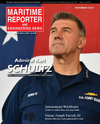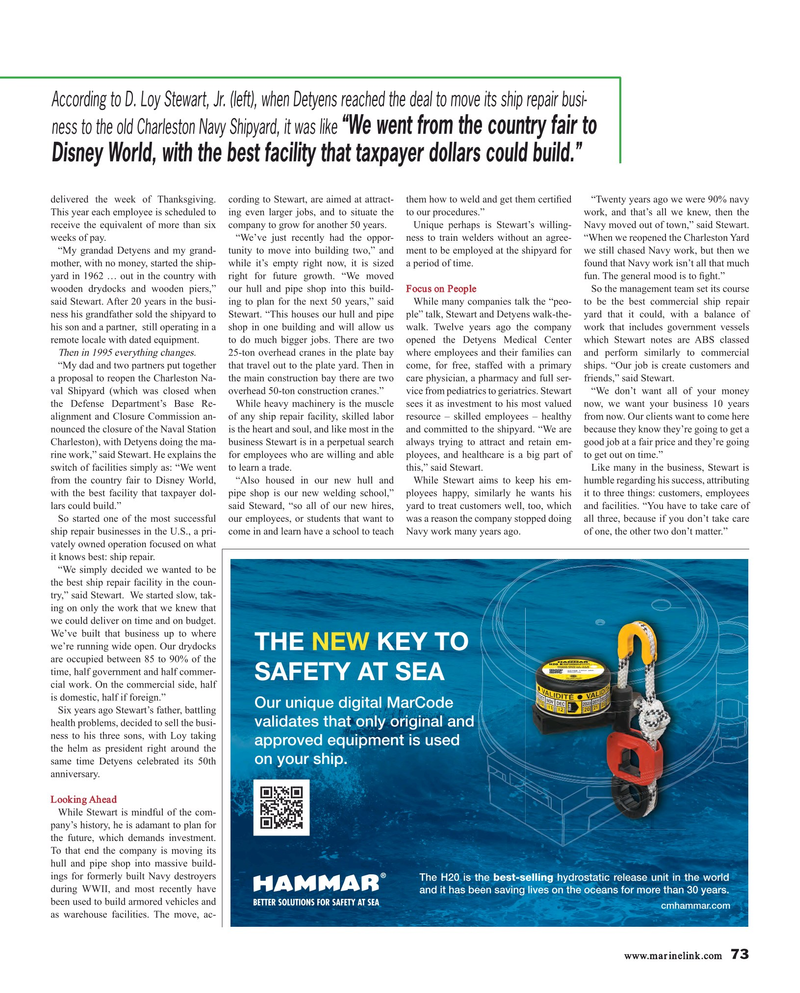
Page 73: of Maritime Reporter Magazine (November 2018)
Workboat Edition
Read this page in Pdf, Flash or Html5 edition of November 2018 Maritime Reporter Magazine
According to D. Loy Stewart, Jr. (left), when Detyens reached the deal to move its ship repair busi- “We went from the country fair to ness to the old Charleston Navy Shipyard, it was like
Disney World, with the best facility that taxpayer dollars could build.” delivered the week of Thanksgiving. cording to Stewart, are aimed at attract- them how to weld and get them certi? ed “Twenty years ago we were 90% navy
This year each employee is scheduled to ing even larger jobs, and to situate the to our procedures.” work, and that’s all we knew, then the receive the equivalent of more than six company to grow for another 50 years. Unique perhaps is Stewart’s willing- Navy moved out of town,” said Stewart. weeks of pay. “We’ve just recently had the oppor- ness to train welders without an agree- “When we reopened the Charleston Yard “My grandad Detyens and my grand- tunity to move into building two,” and ment to be employed at the shipyard for we still chased Navy work, but then we mother, with no money, started the ship- while it’s empty right now, it is sized a period of time. found that Navy work isn’t all that much yard in 1962 … out in the country with right for future growth. “We moved fun. The general mood is to ? ght.” wooden drydocks and wooden piers,” our hull and pipe shop into this build- Focus on People So the management team set its course said Stewart. After 20 years in the busi- ing to plan for the next 50 years,” said While many companies talk the “peo- to be the best commercial ship repair ness his grandfather sold the shipyard to Stewart. “This houses our hull and pipe ple” talk, Stewart and Detyens walk-the- yard that it could, with a balance of his son and a partner, still operating in a shop in one building and will allow us walk. Twelve years ago the company work that includes government vessels remote locale with dated equipment. to do much bigger jobs. There are two opened the Detyens Medical Center which Stewart notes are ABS classed
Then in 1995 everything changes. 25-ton overhead cranes in the plate bay where employees and their families can and perform similarly to commercial “My dad and two partners put together that travel out to the plate yard. Then in come, for free, staffed with a primary ships. “Our job is create customers and a proposal to reopen the Charleston Na- the main construction bay there are two care physician, a pharmacy and full ser- friends,” said Stewart. val Shipyard (which was closed when overhead 50-ton construction cranes.” vice from pediatrics to geriatrics. Stewart “We don’t want all of your money the Defense Department’s Base Re- While heavy machinery is the muscle sees it as investment to his most valued now, we want your business 10 years alignment and Closure Commission an- of any ship repair facility, skilled labor resource – skilled employees – healthy from now. Our clients want to come here nounced the closure of the Naval Station is the heart and soul, and like most in the and committed to the shipyard. “We are because they know they’re going to get a
Charleston), with Detyens doing the ma- business Stewart is in a perpetual search always trying to attract and retain em- good job at a fair price and they’re going rine work,” said Stewart. He explains the for employees who are willing and able ployees, and healthcare is a big part of to get out on time.” switch of facilities simply as: “We went to learn a trade. this,” said Stewart. Like many in the business, Stewart is from the country fair to Disney World, “Also housed in our new hull and While Stewart aims to keep his em- humble regarding his success, attributing with the best facility that taxpayer dol- pipe shop is our new welding school,” ployees happy, similarly he wants his it to three things: customers, employees lars could build.” said Steward, “so all of our new hires, yard to treat customers well, too, which and facilities. “You have to take care of
So started one of the most successful our employees, or students that want to was a reason the company stopped doing all three, because if you don’t take care ship repair businesses in the U.S., a pri- come in and learn have a school to teach Navy work many years ago. of one, the other two don’t matter.” vately owned operation focused on what it knows best: ship repair. “We simply decided we wanted to be the best ship repair facility in the coun- try,” said Stewart. We started slow, tak- ing on only the work that we knew that we could deliver on time and on budget.
We’ve built that business up to where we’re running wide open. Our drydocks
THE NEW KEY TO are occupied between 85 to 90% of the time, half government and half commer-
SAFETY AT SEA cial work. On the commercial side, half is domestic, half if foreign.”
Our unique digital MarCode
Six years ago Stewart’s father, battling health problems, decided to sell the busi- validates that only original and ness to his three sons, with Loy taking approved equipment is used the helm as president right around the on your ship.
same time Detyens celebrated its 50th anniversary.
Looking Ahead
While Stewart is mindful of the com- pany’s history, he is adamant to plan for the future, which demands investment.
To that end the company is moving its hull and pipe shop into massive build- ings for formerly built Navy destroyers
The H20 is the best-selling hydrostatic release unit in the world during WWII, and most recently have and it has been saving lives on the oceans for more than 30 years.
been used to build armored vehicles and cmhammar.com as warehouse facilities. The move, ac-
Typ 08 - The New Key to Safety at Sea - 178x127.indd 1 2018-06-28 13:42:56 www.marinelink.com 73
MR #11 (66-73).indd 73 MR #11 (66-73).indd 73 11/16/2018 9:36:18 AM11/16/2018 9:36:18 AM

 72
72

 74
74
